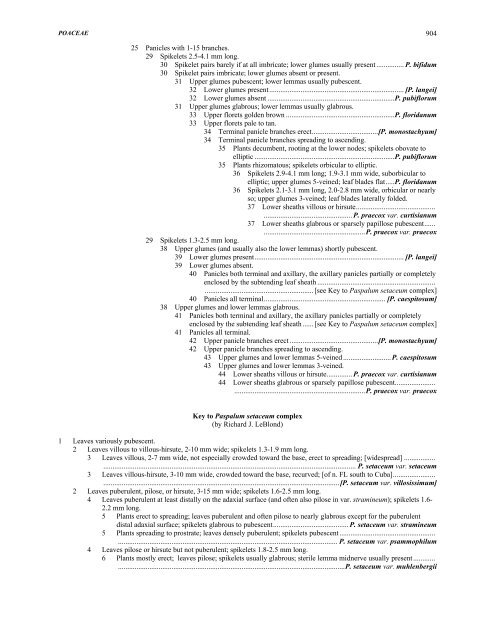Part 7 - UNC Herbarium
Part 7 - UNC Herbarium
Part 7 - UNC Herbarium
Create successful ePaper yourself
Turn your PDF publications into a flip-book with our unique Google optimized e-Paper software.
POACEAE 904<br />
25 Panicles with 1-15 branches.<br />
29 Spikelets 2.5-4.1 mm long.<br />
30 Spikelet pairs barely if at all imbricate; lower glumes usually present ............... P. bifidum<br />
30 Spikelet pairs imbricate; lower glumes absent or present.<br />
31 Upper glumes pubescent; lower lemmas usually pubescent.<br />
32 Lower glumes present......................................................................... [P. langei]<br />
32 Lower glumes absent .....................................................................P. pubiflorum<br />
31 Upper glumes glabrous; lower lemmas usually glabrous.<br />
33 Upper florets golden brown ...........................................................P. floridanum<br />
33 Upper florets pale to tan.<br />
34 Terminal panicle branches erect....................................[P. monostachyum]<br />
34 Terminal panicle branches spreading to ascending.<br />
35 Plants decumbent, rooting at the lower nodes; spikelets obovate to<br />
elliptic ............................................................................P. pubiflorum<br />
35 Plants rhizomatous; spikelets orbicular to elliptic.<br />
36 Spikelets 2.9-4.1 mm long; 1.9-3.1 mm wide, suborbicular to<br />
elliptic; upper glumes 5-veined; leaf blades flat.....P. floridanum<br />
36 Spikelets 2.1-3.1 mm long, 2.0-2.8 mm wide, orbicular or nearly<br />
so; upper glumes 3-veined; leaf blades laterally folded.<br />
37 Lower sheaths villous or hirsute...........................................<br />
................................................ P. praecox var. curtisianum<br />
37 Lower sheaths glabrous or sparsely papillose pubescent......<br />
.......................................................P. praecox var. praecox<br />
29 Spikelets 1.3-2.5 mm long.<br />
38 Upper glumes (and usually also the lower lemmas) shortly pubescent.<br />
39 Lower glumes present................................................................................. [P. langei]<br />
39 Lower glumes absent.<br />
40 Panicles both terminal and axillary, the axillary panicles partially or completely<br />
enclosed by the subtending leaf sheath ................................................................<br />
........................................................... [see Key to Paspalum setaceum complex]<br />
40 Panicles all terminal.................................................................. [P. caespitosum]<br />
38 Upper glumes and lower lemmas glabrous.<br />
41 Panicles both terminal and axillary, the axillary panicles partially or completely<br />
enclosed by the subtending leaf sheath ...... [see Key to Paspalum setaceum complex]<br />
41 Panicles all terminal.<br />
42 Upper panicle branches erect ................................................[P. monostachyum]<br />
42 Upper panicle branches spreading to ascending.<br />
43 Upper glumes and lower lemmas 5-veined .......................... P. caespitosum<br />
43 Upper glumes and lower lemmas 3-veined.<br />
44 Lower sheaths villous or hirsute.............. P. praecox var. curtisianum<br />
44 Lower sheaths glabrous or sparsely papillose pubescent......................<br />
.......................................................................P. praecox var. praecox<br />
Key to Paspalum setaceum complex<br />
(by Richard J. LeBlond)<br />
1 Leaves variously pubescent.<br />
2 Leaves villous to villous-hirsute, 2-10 mm wide; spikelets 1.3-1.9 mm long.<br />
3 Leaves villous, 2-7 mm wide, not especially crowded toward the base, erect to spreading; [widespread] .................<br />
......................................................................................................................................... P. setaceum var. setaceum<br />
3 Leaves villous-hirsute, 3-10 mm wide, crowded toward the base, recurved; [of n. FL south to Cuba].......................<br />
................................................................................................................................[P. setaceum var. villosissimum]<br />
2 Leaves puberulent, pilose, or hirsute, 3-15 mm wide; spikelets 1.6-2.5 mm long.<br />
4 Leaves puberulent at least distally on the adaxial surface (and often also pilose in var. stramineum); spikelets 1.6-<br />
2.2 mm long.<br />
5 Plants erect to spreading; leaves puberulent and often pilose to nearly glabrous except for the puberulent<br />
distal adaxial surface; spikelets glabrous to pubescent......................................... P. setaceum var. stramineum<br />
5 Plants spreading to prostrate; leaves densely puberulent; spikelets pubescent....................................................<br />
....................................................................................................................... P. setaceum var. psammophilum<br />
4 Leaves pilose or hirsute but not puberulent; spikelets 1.8-2.5 mm long.<br />
6 Plants mostly erect; leaves pilose; spikelets usually glabrous; sterile lemma midnerve usually present............<br />
...........................................................................................................................P. setaceum var. muhlenbergii













